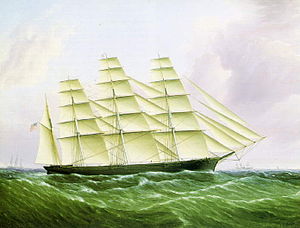Great Republic

Clipper barque Great Republic, painting by James E. Buttersworth
|
|
| History | |
|---|---|
|
|
|
| Name: | Great Republic |
| Namesake: | Poem by Henry Wadsworth Longfellow |
| Owner: |
|
| Ordered: | 1852 |
| Builder: | Donald McKay (designer & builder) |
| Cost: | $ 450,000.00 (1853) |
| Laid down: | 1852 |
| Launched: | October 4, 1853 |
| Christened: | October 4, 1853 by Capt. A. Gifford |
| Maiden voyage: | February 24, 1855 to Liverpool, England |
| In service: | 1854 |
| Out of service: | 1872 |
| Renamed: | Denmark in 1869 |
| Reclassified: | 1862 as a three-masted full-rigged ship |
| Homeport: | Boston (1853); New York (1855); Yarmouth, Nova Scotia (1866), Liverpool (1868) |
| Identification: | |
| Fate: | sunk in storm off Bermuda on March 5, 1872 |
| Badge: | figurehead: gilded eagle and a second gilded eagle with outstretched wings across the stern board |
| General characteristics | |
| Class and type: | |
| Tonnage: | 4,555 GRT / 4,100 NRT; after rebuild 3,357 GRT / 3,100 NRT |
| Displacement: | ~6,600 tons (5,000 tons cargo plus 1,600 tons ship's mass) |
| Length: |
|
| Beam: | 53 ft (16 m) |
| Height: |
|
| Draught: | 25 ft (7.6 m) |
| Decks: | 4 continuous wooden decks, after rebuilt: 3 (with additional poop and forecastle decks) |
| Deck clearance: | 8 ft |
| Propulsion: | Sails |
| Sail plan: |
|
| Speed: | 19 kn (35.2 km/h) |
| Capacity: | 5,000 tons max. |
| Complement: | 60; originally planned: 120 |
Launched on October 4, 1853 Great Republic is noteworthy as the largest wooden clipper ship ever constructed.
Designed by naval architect and shipbuilder Donald McKay as a four-deck four-masted medium clipper barque, Great Republic—at 4,555 tons registry—was intended to be the most profitable wooden sailing ship ever to ply the Australian gold rush and southern oceans merchant trade. The ship's launch was planned for September 4, 1853—builder Donald McKay's birthday—but it was postponed to October 4 due to problems with the timber supplies. The City of Boston made the launch a public holiday. Between 30,000 and 50,000 spectators attended, among them Ferdinand Laeisz of the Flying P-Line of Hamburg. The ship was christened by Captain Alden Gifford using a bottle of pure Cochituate water. The ship's name was drawn from the title of a poem by Henry Wadsworth Longfellow. After outfitting, Great Republic sailed in ballast from Boston to New York, where in December 1853 her first cargo was loaded.
Great Republic required "1,500,000 feet of pine ... 2,056 tons of white oak, 336½ tons of iron, and 56 tons of copper" - about three times as much pine as was typically required for a large clipper ship.
On December 27, 1853 a fire broke out in the buildings of the Novelty Baking Company near the piers where Great Republic and several other wooden merchant vessels were moored. The fire quickly spread to the packet ship Joseph Walker, and to the clippers White Squall, Whirlwind, Red Rover and Great Republic. The first three ships were destroyed, Red Rover was damaged, and Great Republic burnt to near the waterline.Great Republic was declared a total loss, and Donald McKay, who never got over the loss, was compensated by insurers. The sunken hulk was sold by the insurance underwriters to Captain Nathaniel Palmer who salvaged and rebuilt it as a three-deck vessel with reduced masts.
Still the largest clipper ship in the world at 3,357 tons registry, Great Republic, under command of Captain Joseph Lymburner, started back in merchant service on February 24, 1855. Her maiden voyage brought her to Liverpool in 13 days.
...
Wikipedia
